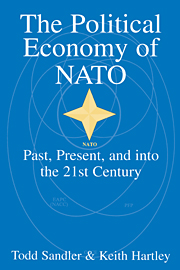Book contents
- Frontmatter
- Contents
- List of tables and figures
- Preface
- 1 NATO at the crossroads: An introduction
- 2 NATO burden sharing and related issues
- 3 On NATO expansion
- 4 NATO and peacekeeping
- 5 NATO and the defense industrial base: EU and USA
- 6 NATO challenges on the horizon
- 7 NATO and Europe
- 8 NATO design
- 9 Conclusions and future scenarios
- References
- Author index
- Subject index
1 - NATO at the crossroads: An introduction
Published online by Cambridge University Press: 05 June 2012
- Frontmatter
- Contents
- List of tables and figures
- Preface
- 1 NATO at the crossroads: An introduction
- 2 NATO burden sharing and related issues
- 3 On NATO expansion
- 4 NATO and peacekeeping
- 5 NATO and the defense industrial base: EU and USA
- 6 NATO challenges on the horizon
- 7 NATO and Europe
- 8 NATO design
- 9 Conclusions and future scenarios
- References
- Author index
- Subject index
Summary
Unquestionably, the North Atlantic Treaty Organization (NATO) has been one of the most successful and resilient alliances ever created. NATO has weathered innumerable crises – France's withdrawal from NATO's integrated military structure, Turkey's invasion of Cyprus, coups d'état in Portugal, Greece, and Turkey. Despite these and other exigencies, NATO has outlasted the Soviet Union and the Warsaw Pact, and, in so doing, has contributed to its Cold War victory. As NATO approaches its half-century mark, it stands at a crossroads. The Cold War is over and, with its end, the threat of nuclear East-West confrontation has become, at this writing, an unlikely scenario. Although military budgets of the NATO allies and the ex-Warsaw Pact countries have declined greatly in real spending terms, the world is still a dangerous place. Civil wars in Bosnia, Somalia, Haiti, and the former Soviet republics underscore these dangers. The democratization of the former communist nations has unbridled pent-up ethnic hostilities that have erupted into conflicts that can transcend borders and engulf neighboring nations (Boczek, 1995; Carlier, 1995). Ethnic conflicts continue to threaten the former Soviet republics of Azerbaijan, Armenia, Tajikistan, Georgia, Moldova, and Chechnya. Industrial nations remain dependent on resources imported, in part, from countries in the Middle East, East and Central Africa, and Asia, which face political instability and possible conflict. If resource supplies to the industrial world are to be secure, NATO must be prepared to contend with crises and conflicts outside of Europe.
- Type
- Chapter
- Information
- The Political Economy of NATOPast, Present and into the 21st Century, pp. 1 - 21Publisher: Cambridge University PressPrint publication year: 1999



